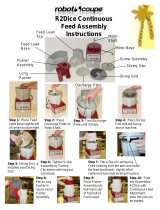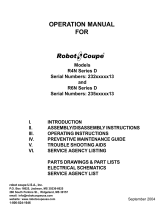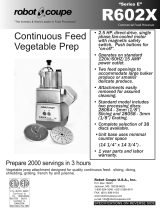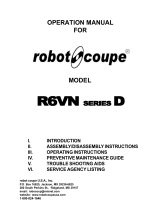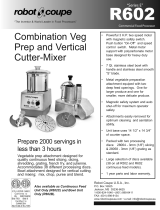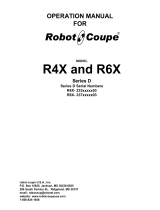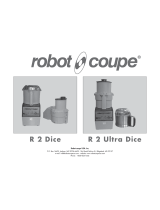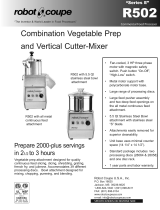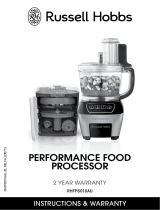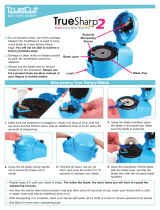
R502 and R602 Operation Manual
Series E versions
9
D. GENERAL HINTS:
1. Be sure your Robot Coupe is properly assembled before
using.
2. Always insure blade and attachment are tightly in place.
3. Do not fill the cutter bowl over 3/4 full.
4. Learn to operate the cutter bowl using a start - stop
motion so the consistency of the prepared product can
be controlled. Remember it is important to start with
uniform pieces for uniform results.
5. Wash the bowl, blade and cover after every use. Do not
store food in the bowl.
6. If the motor does not start when the switch is on and lid
is fully in position, disengage the lid (machine is now off)
and check to see if the attachment is locked in place. If
okay, unplug the unit and see if any food is jamming the
blade.
7. If the machine malfunctions for any reason, discard any
food being processed at that time.
IV. PREVENTIVE MAINTENANCE/TROUBLE
SHOOTING AIDS:
The Robot Coupe has been designed to provide maximum
trouble free performance. Adherence to the assembly and
operating instructions will further assure good performance.
Additionally, if simple common sense rules are applied, a long
life utilization will be achieved.
(1) Care: While the Robot Coupe is a ruggedly constructed
machine, overall handling should be accomplished with a
sense of use rather than abuse. The continuous feed attach-
ment and the motor housing are made of rugged cast alumi-
num and will yield a long life if not mistreated. While the ma-
chine is reasonably portable, care should be taken not to drop
it. Remove the continuous feed and any plates or other at-
tachments before relocating the machine. Your Robot Coupe
should never be picked up by the continuous feed lead the
bowl or the cord. Always lift from the bottom of the motor
base assembly. Care should be exercised in relocating it.
Equal caution should be exercised in handling all of the parts
to assure they are not subject to undue force.
(2) Cleaning: Proper cleaning of the machine is one of the
most important preventive maintenance measures the user
can employ. The high acid content of food can cause harm to
electrical parts contained within the housing. Although these
elements are isolated from the outside through seals, veg-
etable juices will tend to seep. If vegetable juices are permit-
ted to collect on the machine over periods of use, erosion of
the seals can occur. It is recommended that the machine be
cleaned after each operational use, and at least once per day.
Correct cleaning procedures are required to assure that dam-
age is not inflicted in the cleaning process. The motor sup-
port/base assembly contains the motor and electrical compo-
nents.
DO NOT IMMERSE THE MOTOR BASE
ASSEMBLY IN WATER.
While the continuous feed lead, pushers and discs are dish-
water safe , some additional cleaning may be required. Clean-
ing of the discs should be accomplished with care to help pre-
vent cuts. A stiff bristle brush will be effective in knocking the
food out of the crevices.
Cleaning of the motor/base assembly must be done with care.
First, unplug the unit. A sponging with a soluble detergent is
acceptable, making sure the water is not permitted to pen-
etrate the seals. Clean around the seals with a small brush,
taking care to remove all food. Clean the motor shaft with a
small brush.
Read the label for the dish machine detergent you are using
to determine if it is safe for soft metals. If you can not deter-
mine if it is safe for soft metals, then contact your supplier for
this information. Many other cleaning detergents can also
cause corrosion of soft metals.
Do not wash the aluminum parts of this machine using a non-
metal safe detergent either in a dish machine or pot sink! Clean
the aluminum feed attachment using only soft metal safe de-
tergents.
While the continuous feed lead, pushers and discs are dish-
washer safe if used with a metal safe detergent, some addi-
tional cleaning may be required. Cleaning of the plates should
be accomplished with care to help prevent cuts. A stiff bristle
brush will be effective in knocking the food out of the crevices.
The “S” blade assembly should be taken completely apart
and washed after each days use for sanitary reasons, and
also to prevent the parts from becoming jammed or “freezing
up”. Follow the previous assembly/disassembly instructions
carefully and wear cut-resistant gloves when han-
dling the cutting blades.
(3) Preventive Maintenance: In addition to cleaning the seals,
an examination should be made periodically to insure that a
seal against food is being maintained. With proper care, and
depending on use, the seals should last for a year or more.
However, they can and should be replaced when wear or ero-
sion is noted. It is recommended that the seals be replaced
by an authorized repair agency.
Good operational performance is obtained when the blades
are sharp. Continued use can dull the blades. All of the slic-
ing and grating discs are made so that the blade can be re-
placed when they become dull. Always store the disc in the
disc holders. Additional disc holders can be obtained from
your food service distributor.




















